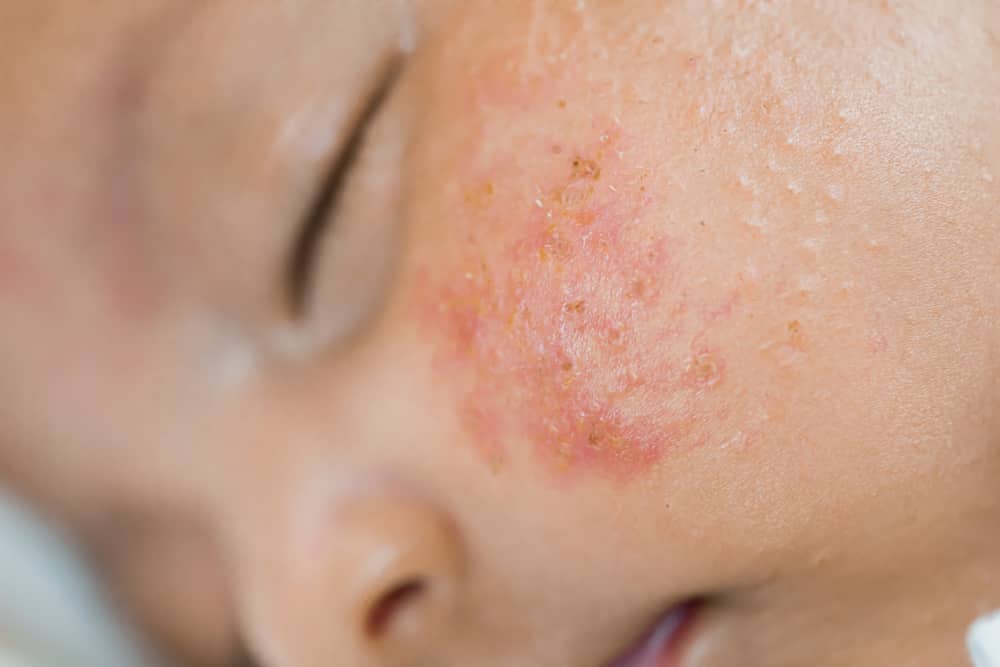Acne is the bane of adolescence, but babies can get it as well, which often surprises new parents. Baby acne, also called newborn acne or neonatal acne, affects many newborns. Babies rarely develop acne as infants (infantile acne).
Baby acne is usually harmless and goes away on its own. Still, it's critical to understand how to avoid irritating your baby's skin and when to take your baby to a dermatologist to ensure the condition doesn't require treatment.
Key Points
- This acne is characterized by pimples that appear on your baby's face, neck, back, and/or upper chest. It usually appears within the first six weeks of life.
- Baby acne will generally clear up by four months of age.
- Scientists aren't yet sure what causes baby acne. There are, however, a few leading theories. One belief is that baby acne is caused by hormones from the mother, which remain in the baby for the first part of their life.
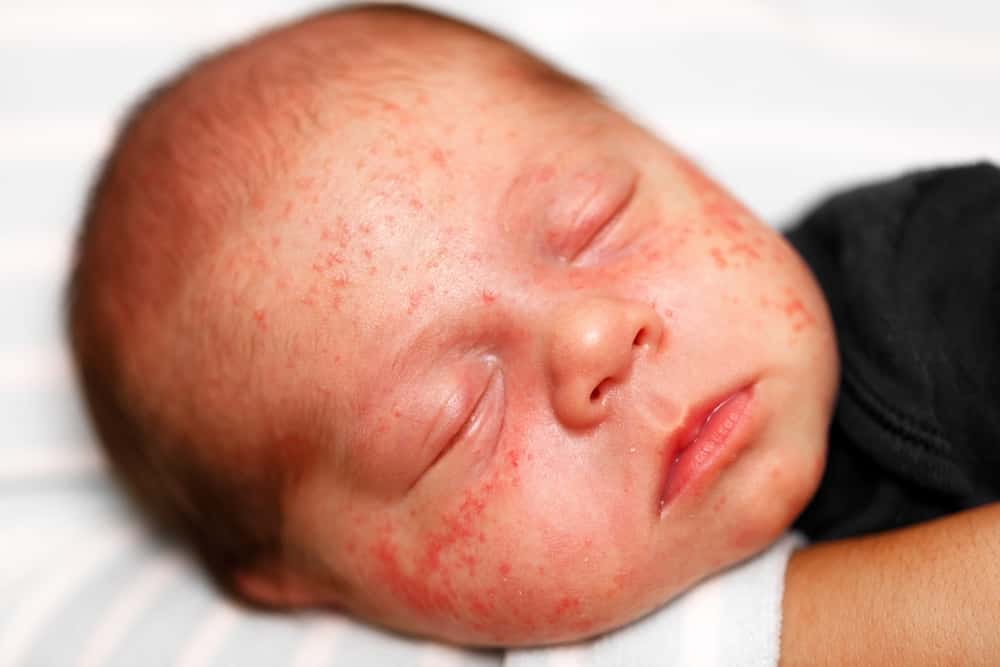
Baby acne usually goes away on its own and has no harmful after-effects on your baby.
©Ruslan Ivantsov/Shutterstock.com
What is Baby Acne?
Baby acne, also known as erythema toxicum neonatorum or neonatal acne, is characterized by pimples that appear on a baby's face, neck, back, and/or upper chest, in a manner similar to adolescent acne. This is common between the ages of two and four weeks. This may sound concerning, but it is a harmless skin condition that will resolve on its own.
It usually appears between the ages of two and four weeks, but can appear at any time before the age of six weeks. It is estimated that 20% to 40% of babies under the age of six weeks are affected.
Baby acne is a lot different from acne which affects adolescents and adults. It is also distinct from the skin condition known as infantile acne. Baby acne appears in the first few months of your baby's life, whereas infantile acne can last into their second year, and is far less common than baby acne.
Baby acne, fortunately, is only temporary. It should go away on its own eventually – usually by 4 months of age. It also does not leave permanent scars, unlike teen acne.
Is Infantile Acne the Same as Baby Acne?
While the symptoms of both conditions are similar, the difference between baby acne and infantile acne is when it affects your child. Baby acne appears around the age of 2 weeks. Some babies are born with acne, which resolves within a few weeks. Infantile acne occurs between the ages of 2 months and 1 year. Infantile acne symptoms can include blackheads in addition to pimples and bumps. Consult a doctor if your child develops acne after the age of 2 months. Infantile acne may take longer to clear up.
Causes of Baby Acne
It is unknown what causes baby acne. Despite this uncertainty, there are several theories circulating. Hormones are thought to be the cause of acne in teens. However, the mother's hormones may be to blame in the case of baby acne. Some of their mother's hormones remain in their bloodstream from when they were in the womb.
This may cause their oil glands to produce more oil than necessary, clogging the pores and causing pimples to appear. And babies are especially vulnerable because their pores are still developing and their skin is extremely sensitive.
According to some sources, this is due to the fact that babies' pores are still developing and may not be fully equipped to fight pimple-causing bacteria. Other research suggests that baby acne is caused by an inflammatory reaction to Malassezia yeast colonization of the skin.
Others believe that certain medications (taken by the infant or a breastfeeding mother) may increase a baby's chances of developing acne. Others believe that an imbalance in gut flora is to blame.
Furthermore, because a baby's skin is sensitive, it can be irritated by contact with milk, formula, or spit-up, leading to acne. Rough fabrics or clothes washed in harsh detergents can also irritate sensitive skin and aggravate baby acne.
If your baby has acne, consult with your doctor about the best soaps, lotions, or creams to use, as some can cause irritation. Natural treatment and prevention strategies, regardless of the cause, may help in the healing process.
What are the Symptoms of Baby Acne?
A red, blotchy rash on your baby's skin with small, raised spots called papules is the most common symptom of baby acne. Spots on the face are common in babies, especially on the cheeks, nose, and forehead. However, baby acne can appear anywhere on the body, including the neck, back, and chest. Baby acne affects the arms and legs less frequently. Pustules are small pus-filled spots that may appear on your baby.
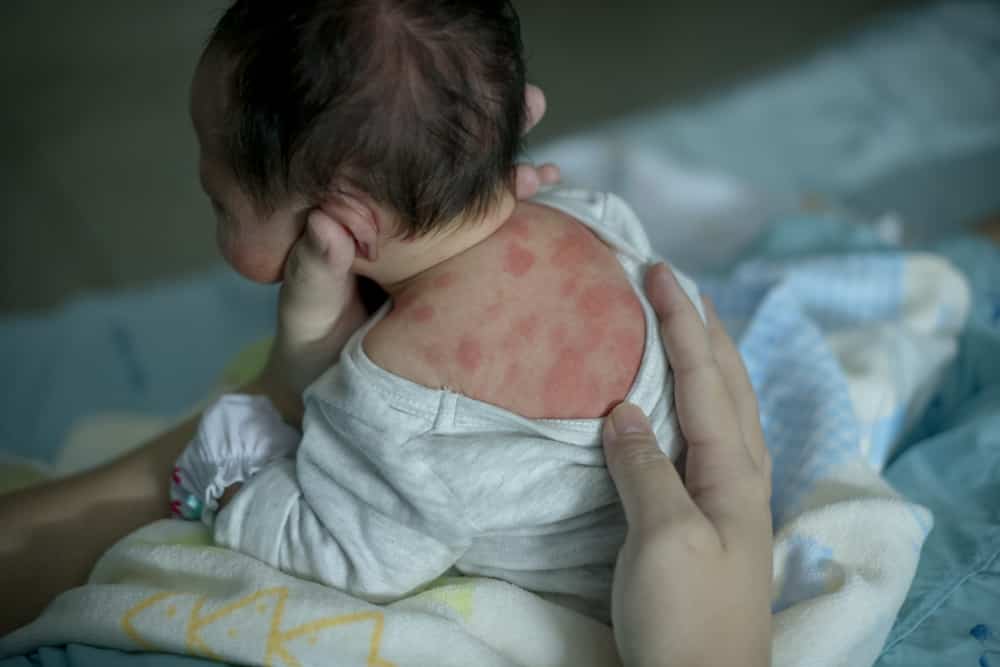
Baby acne can appear anywhere on your little one, including their back.
©Palookpook/Shutterstock.com
The number and size of spots on your baby can vary. The duration of the rash can also vary. Sometimes spots vanish within hours, while new ones appear elsewhere. The spots will fade if you press on them.
It is important to note that baby acne does not make your baby sick. Despite the fact that it may appear frightening. Try not to be concerned because it has no effect on their overall health.
How Long Does Baby Acne Last?
Neonatal acne may last a month and then clear up without leaving any scars. In some cases, it may last a few months before disappearing without medical intervention.
Infantile acne, on the other hand, can last for months but will begin to fade once the baby reaches 12 months. However, this acne tends to last until the child is 3 years old, at which point it leaves a permanent scar. In the case of infantile acne, medical attention may be required.
Baby Acne Treatment
While baby acne usually goes away on its own, there are a few things parents can do to help it heal faster. We'll go over how to treat baby acne on the face, as well as on the body or chest, in the sections below.
Avoid adult acne treatments
While there are numerous over-the-counter acne treatments available, these products are designed for teenagers and adults and are generally too harsh for babies skin. As a result, it's critical to avoid using any acne treatment unless it's prescribed by a pediatrician or pediatric dermatologist.
Think about taking probiotic supplements
There is some evidence that probiotics may aid your little one's immune system in fighting acne (or help to prevent the worsening of acne). Probiotics can potentially calm the skin cells and decrease inflammation. For these reasons, it's worth checking with your pediatrician to see if breastfeeding mothers should consider increasing their probiotic intake, or if there are other ways to increase your baby's exposure to probiotics.
Clean your baby on a regular basis
Wash your baby's face once a day using a mild, moisturizing soap (or none at all), and warm water. This will remove saliva and spit-up and help to keep their pores clean, both of which can irritate acne if they remain on their face. (If your baby has saliva or spit-up on their face, wash it off right away gently with lukewarm water if it is not yet time for their daily face cleaning.) Use no lotions or oily products on your baby's sensitive skin.
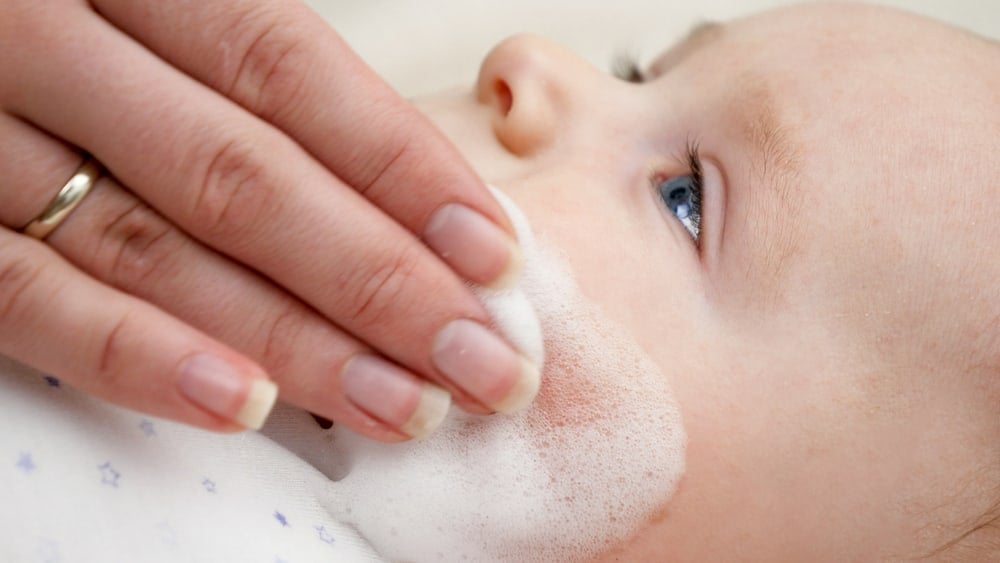
When cleaning a baby with acne, it's best to use warm water with mild soap, or none at all.
©kryzhov/Shutterstock.com
Avoid scrubbing the acne with a towel or other abrasive product. To avoid further irritation, pat your baby's face dry rather than rubbing it.
Pimples should not be squeezed or popped
Although tempting, popping your baby's pimples will only cause skin irritation and increase the risk of infection, escalating the problem. Squeezing pimples increases the risk of scarring, so resist the urge.
Avoid using harsh detergents and putting clothes with rough fabrics on your baby
Rough, scratchy fabrics can cause irritation to the acne and cause it to heal more slowly. The same can be said about detergents containing artificial fragrances and other potentially irritating or harmful chemicals. Avoid exposing your child to these products by using a fragrance-free detergent and soft clothing and bedding.
Prevent your baby from scratching
If your baby's acne is bothering them, they may develop a habit of scratching or rubbing at it, which can aggravate the condition and make it worse. As a result, keeping your baby's nails short is a good idea. If they simply can't stop swiping at the acne, you might find it helpful to put soft cotton gloves on their hands.
Loosen up your baby!
It may also be beneficial to avoid over-clothing or swaddling your baby. Tight-fitting fabrics reduce air circulation to the skin, making it easier for skin conditions to develop. Instead, choose looser-fitting, breathable fabrics.
If your baby's acne persists or you have other concerns about their skin, you should consult your pediatrician or a pediatric dermatologist to determine the best next steps for your child. Remember to be patient as you try to treat your baby's acne; the condition will clear up eventually, even if it takes some time.
Baby Acne vs. Other Skin Conditions/Skin Rashes
Baby acne can resemble rashes and other skin conditions. Before proceeding, ensure that the baby has acne and not another skin condition. It's smart to consult a doctor before making a determination; avoid self-diagnosing. Here are some skin rashes and conditions that can be confused with baby acne, as well as how to tell them apart.
Heat Rash
Heat rashes resemble acne but appear suddenly when it's hot outside. Furthermore, heat rashes typically appear on areas of the baby's body that are prone to becoming hot. As a result, they may appear on the face. However, heat rashes can appear on a baby's armpits, wrists, and other parts of their arms and legs (where baby acne does not usually appear).
Cradle Cap
Cradle cap is characterized by rough yellow, white, or brown patches on the scalp. These patches will be very thick, flaky, and occasionally oily. In older children and adults, the patches will flake off, similar to dandruff. Cradle cap can cause bumps that resemble baby acne, but cradle cap bumps are more concentrated on the scalp, smaller, and usually accompanied by flaky patches.
Baby Eczema (Atopic Dermatitis)
Baby eczema causes dry, rough, flaky, itchy, and sometimes red skin. When a baby's skin is exposed to irritants, eczema flares up (worsens). It does not cause bumps or raised pimples.
Milia
These are tiny white bumps that appear on some babies' faces and are caused by dead skin cells that become trapped in the baby's skin pockets. Milia is unrelated to baby acne and, just like baby acne, will go away on its own.
Hives from Food Allergy (Food Allergy Rash)
Food allergy hives form when a baby's immune system over-protects the body against proteins from food to which the baby is allergic. They manifest as raised, often red bumps that can appear anywhere on the body. They appear suddenly and disappear within a few hours after the baby eats a food to which they are allergic (lasting no more than 24-48 hours). If a food allergy rash appears all over the baby, epinephrine and medical attention are required.
Erythema toxicum
This rash usually appears a few days after birth. It presents as blotchy and red, with blisters that have a small white or yellow center. A majority of newborns will get this rash, but it will disappear within a few days. Although the blisters may look like a cause for concern, rest assured that Erythema toxicum is completely harmless.
Transient neonatal pustular melanosis
This condition appears very early in a newborn's life, like Erythema toxicum. It presents as small, pus-filled spots on the forehead, neck, chest, thighs, and/or small of the back. The condition will usually clear up within several days, but may leave dark spots behind that take months to clear up.
When Should You Go to the Doctor?
If your baby has baby acne, you usually don't need to see a doctor because it goes away on its own. Your baby may have infantile acne if it developed acne after the age of 6 weeks. This is a more severe case of baby acne that can scar the skin, so you should consult your doctor. There are infantile acne treatments available.
It is also important to consult a doctor if you are unsure whether your baby has acne, especially if they are ill because some rashes can be more serious. Consult a doctor if your baby has a fever, is not feeding, is more sleepy than usual, or otherwise appears abnormal. You know your baby best, so seek advice if you are concerned about anything.
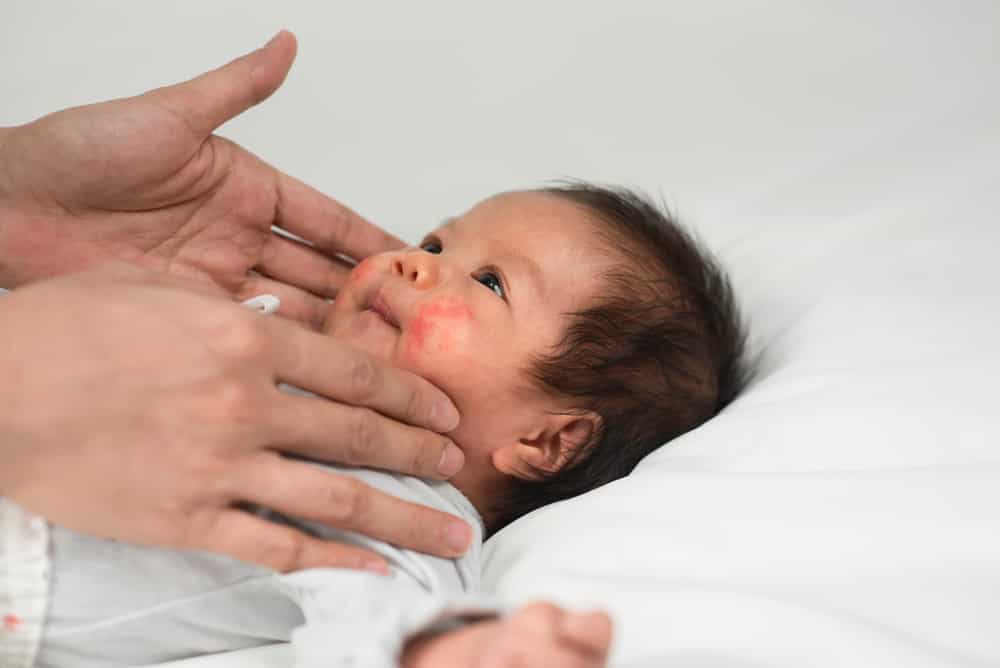
Baby acne is harmless and should not be a reason to worry.
©fotorawin/Shutterstock.com
Conclusion
Baby acne, also known as infantile acne, is a common and usually harmless condition that affects up to 20% of newborns. There is no need to be concerned if your child develops this condition. Consulting your pediatrician and using the natural treatment options described above should help the condition clear up as quickly as possible.
Remember to help your baby avoid the desire to pick at or scratch the acne; harsh detergents, rough fabrics, and over-the-counter acne treatments. Use gentle and natural products on your baby to keep his face clean.
Meanwhile, putting in place the natural prevention strategies like the ones described above will lay the groundwork for your little one to have healthier skin in the future.
The image featured at the top of this post is ©Kung37/Shutterstock.com
